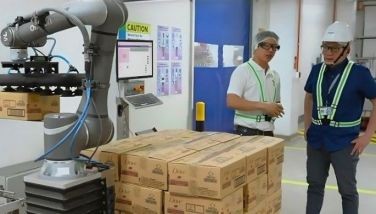Silliman Stopover
October 12, 2003 | 12:00am
Travelers don’t usually go looking for school during their vacation. But dolphin watching in Bais found us with a couple of hours to spare in Dumaguete City. This provincial capital of Negros Oriental is synonymous with Silliman University, founded by American missionaries in 1901 and is the only Protestant university in the country. Its 33-hectare campus is at the heart of the city, with facilities spreading to the suburbs. The central role of Silliman in the city creates the unique charm of a university town. All travel guidebooks suggest taking a trip to the famed university, so we did.
Dressed like college students in jeans and a comfortable t-shirt, my friend Jenny and I walked from our hotel to Silliman. At the gates, the acacia trees are reminiscent of UP Diliman’s ambiance of scholarly pursuit. The happy memories of college life came flooding back as we walked through the chapel, library and other school buildings. Luce Auditorium, a facitilty for international cultural performances and student events, stands out with its modern architecture. Unlike the universities in Manila which look like giant parking lots, motorcycles make it a breeze for students to get around. Others use the trusty tricycle costing only P4.
Named after its founding father Dr. Horace B. Silliman, the university served as a Japanese headquarters during World War II. As we strolled around the campus, we set out to find the Anthropology Museum the university is famous for. Reading from travel guides, the museum is reputed for its collection of voodoo paraphernalia from nearby Siquijor, locally excavated artifacts, Sung and Ming porcelains, and rare shells. Unfortunately, the security guard assigned to one outpost told us it was already closed.
We decided to head to the Silliman University Marine Laboratory in Bantayan Beach, about 15 minutes away. The Marine Laboratory was established in 1974 as a facility where researches in taxonomy, biology, conservation, management and feasible marine culture are conducted. Through the assistance of usaid, the marine center houses four laboratories: marine botany and biochemistry, genetics, invertebrate and vertebrate. It has a modest library, herbarium and zoological museum, a dive shop, flowing sea/freshwater systems, experimental fishponds, tanks, culture facilities and a mangrove garden.
Biology and the sciences were not my favorite subjects, yet suml managed to entertain and educate this student for a day. The remains of a sperm whale stranded in Siquijor recovered last September 23, 2000 is on display in the lawn. I learned these mammals are deep divers going 2,800 meters down, and can grow up to 18 meters long. They feed on giant squid, salmon, rockfish and octopus.
Three preserved turtles were on display: a hawksbill turtle from Bohol, a leatherback turtle and a green turtle. An aquarium of soft corals, hard corals, sea cucumber and sea grass enable visitors who never had the opportunity to dive or snorkel to have a chance to see marine life up close.
Students from Silliman usually conduct the tours around suml, but on this day we happily settled with Lolong the security guard and Daniel the dive master. As we reached the tanks filled with clams, we learned that they live up to hundreds of years, weighing up to hundreds of kilos. While those being cultivated in the tanks are only as big as a fist, when they reach six years they are transferred to the bottom of the ocean.
While fish is a daily staple of my family’s diet, I have never seen lapu-lapu (grouper) as humongous as the one we encountered. At 17 kilos, this fish didn’t appear appetizing at all, but was actually quite a frightening sight with its scales appearing tough and its bulging eyes threatening to attack you. Visitors are warned not to put their fingers near the tank as these sea monsters may bite.
Two 28-year-old crocodiles are the proud parents of several freshwater crocodiles quietly caged, with their other siblings donated to other crocodile farms around the archipelago. Each intimidating reptile eats one kilo of chicken head three times a week.
A room filled with bones from whales made my spine tingle as it reeked of the haunting smell of formalin. Before leaving the sanctuary, we passed by a tank filled with fish. A hyperactive orange fish caught my attention: there he was waving his little fin, just like the cartoon character Nemo, bidding me goodbye.
Our zest for animals and the sciences awakened, we longed to see more. We proceeded back to Silliman campus in search of the Center for Tropical Conservation Studies (centrop). Lost in the tangle of accents, our tricycle driver brought us to the city center instead. We hopped off and found what we were looking for near the ball field across the Medical Arts buildings.
Known as Silliman University Centrop’s AY Reyes Zoological and Botanical Garden, it is quietly tucked at the end of a road. It is home to many large and small animals as well as numerous plants and forest trees. There are a total of 23 species of trees and 16 species of various mammals, reptiles and birds in this lot.
centrop has three ongoing captive breeding projects for the spotted deer, the Visayan warty pig and fruit bats. The animals are protected in suitable enclosures under the canopy of forest trees. These are a few of the Philippine species considered endangered or threatened. Visitors to the garden are given the privilege of seeing these endangered animals up close. An elevated boardwalk was built allowing guests a perfect vantage point to see animals in action.
The star of the garden is the Visayan spotted deer, endemic to Negros. Most young deers are born with spots, which they lose as they mature. This deer, hoever, retains its spots even when full grown. This species has been classified as highly endangered, inspiring Silliman to begin this captive breeding program many years back. Their gentle faces remind one of Disney’s adorable character, Bambi. They kindly stood still and posed for my camera. Unlike the spotted deer, the Philippine brown deer had a bigger, more commanding presence.
Once found all over the Visayas, the Visayan warty pig can now only be seen in isolated areas of Negros and Panay. In this garden two families of the warty pig stood nervously on guard. The clicking sound of my Nikon seemed to intimidate and terrify the papa pig to look out for his young.
The young kids walking around the garden when we visited were thrilled to see the long-tailed macaque monkeys, the freshwater crocodiles, the reticulated python, the freshwater turtles, flying foxes and night heron.
We wanted to spend more time with our fellow creatures of the earth, but with our scheduled departure to Manila only minutes away, we decided it was time to leave the garden and rich wildlife. But it was a very enriching diversion: who would have thought a leisurely stopover in Silliman would turn into an enjoyable lesson in nature?
Dressed like college students in jeans and a comfortable t-shirt, my friend Jenny and I walked from our hotel to Silliman. At the gates, the acacia trees are reminiscent of UP Diliman’s ambiance of scholarly pursuit. The happy memories of college life came flooding back as we walked through the chapel, library and other school buildings. Luce Auditorium, a facitilty for international cultural performances and student events, stands out with its modern architecture. Unlike the universities in Manila which look like giant parking lots, motorcycles make it a breeze for students to get around. Others use the trusty tricycle costing only P4.
Named after its founding father Dr. Horace B. Silliman, the university served as a Japanese headquarters during World War II. As we strolled around the campus, we set out to find the Anthropology Museum the university is famous for. Reading from travel guides, the museum is reputed for its collection of voodoo paraphernalia from nearby Siquijor, locally excavated artifacts, Sung and Ming porcelains, and rare shells. Unfortunately, the security guard assigned to one outpost told us it was already closed.
We decided to head to the Silliman University Marine Laboratory in Bantayan Beach, about 15 minutes away. The Marine Laboratory was established in 1974 as a facility where researches in taxonomy, biology, conservation, management and feasible marine culture are conducted. Through the assistance of usaid, the marine center houses four laboratories: marine botany and biochemistry, genetics, invertebrate and vertebrate. It has a modest library, herbarium and zoological museum, a dive shop, flowing sea/freshwater systems, experimental fishponds, tanks, culture facilities and a mangrove garden.
Biology and the sciences were not my favorite subjects, yet suml managed to entertain and educate this student for a day. The remains of a sperm whale stranded in Siquijor recovered last September 23, 2000 is on display in the lawn. I learned these mammals are deep divers going 2,800 meters down, and can grow up to 18 meters long. They feed on giant squid, salmon, rockfish and octopus.
Three preserved turtles were on display: a hawksbill turtle from Bohol, a leatherback turtle and a green turtle. An aquarium of soft corals, hard corals, sea cucumber and sea grass enable visitors who never had the opportunity to dive or snorkel to have a chance to see marine life up close.
Students from Silliman usually conduct the tours around suml, but on this day we happily settled with Lolong the security guard and Daniel the dive master. As we reached the tanks filled with clams, we learned that they live up to hundreds of years, weighing up to hundreds of kilos. While those being cultivated in the tanks are only as big as a fist, when they reach six years they are transferred to the bottom of the ocean.
While fish is a daily staple of my family’s diet, I have never seen lapu-lapu (grouper) as humongous as the one we encountered. At 17 kilos, this fish didn’t appear appetizing at all, but was actually quite a frightening sight with its scales appearing tough and its bulging eyes threatening to attack you. Visitors are warned not to put their fingers near the tank as these sea monsters may bite.
Two 28-year-old crocodiles are the proud parents of several freshwater crocodiles quietly caged, with their other siblings donated to other crocodile farms around the archipelago. Each intimidating reptile eats one kilo of chicken head three times a week.
A room filled with bones from whales made my spine tingle as it reeked of the haunting smell of formalin. Before leaving the sanctuary, we passed by a tank filled with fish. A hyperactive orange fish caught my attention: there he was waving his little fin, just like the cartoon character Nemo, bidding me goodbye.
Our zest for animals and the sciences awakened, we longed to see more. We proceeded back to Silliman campus in search of the Center for Tropical Conservation Studies (centrop). Lost in the tangle of accents, our tricycle driver brought us to the city center instead. We hopped off and found what we were looking for near the ball field across the Medical Arts buildings.
Known as Silliman University Centrop’s AY Reyes Zoological and Botanical Garden, it is quietly tucked at the end of a road. It is home to many large and small animals as well as numerous plants and forest trees. There are a total of 23 species of trees and 16 species of various mammals, reptiles and birds in this lot.
centrop has three ongoing captive breeding projects for the spotted deer, the Visayan warty pig and fruit bats. The animals are protected in suitable enclosures under the canopy of forest trees. These are a few of the Philippine species considered endangered or threatened. Visitors to the garden are given the privilege of seeing these endangered animals up close. An elevated boardwalk was built allowing guests a perfect vantage point to see animals in action.
The star of the garden is the Visayan spotted deer, endemic to Negros. Most young deers are born with spots, which they lose as they mature. This deer, hoever, retains its spots even when full grown. This species has been classified as highly endangered, inspiring Silliman to begin this captive breeding program many years back. Their gentle faces remind one of Disney’s adorable character, Bambi. They kindly stood still and posed for my camera. Unlike the spotted deer, the Philippine brown deer had a bigger, more commanding presence.
Once found all over the Visayas, the Visayan warty pig can now only be seen in isolated areas of Negros and Panay. In this garden two families of the warty pig stood nervously on guard. The clicking sound of my Nikon seemed to intimidate and terrify the papa pig to look out for his young.
The young kids walking around the garden when we visited were thrilled to see the long-tailed macaque monkeys, the freshwater crocodiles, the reticulated python, the freshwater turtles, flying foxes and night heron.
We wanted to spend more time with our fellow creatures of the earth, but with our scheduled departure to Manila only minutes away, we decided it was time to leave the garden and rich wildlife. But it was a very enriching diversion: who would have thought a leisurely stopover in Silliman would turn into an enjoyable lesson in nature?
BrandSpace Articles
<
>
- Latest
- Trending
Trending
Latest
Trending
Latest
Recommended



















